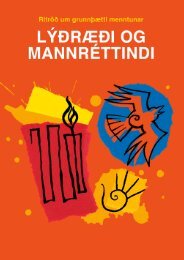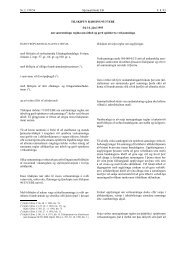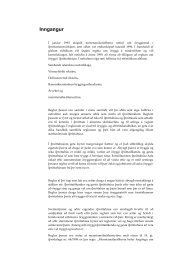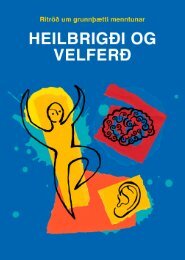Arts and Cultural Education in Iceland : Professor Anne Bamford
Arts and Cultural Education in Iceland : Professor Anne Bamford
Arts and Cultural Education in Iceland : Professor Anne Bamford
Create successful ePaper yourself
Turn your PDF publications into a flip-book with our unique Google optimized e-Paper software.
A future study could exam<strong>in</strong>e specifically the <strong>in</strong>terface between formal provisions <strong>and</strong> the<br />
‘broader’ community provisions. In particular, such research should look at the way these may<br />
work more closely to connect a child’s experiences of the arts. There are also possibilities the<br />
community arts sector could assist <strong>in</strong> leverag<strong>in</strong>g community <strong>and</strong> parental support for the arts <strong>in</strong><br />
the educational sector <strong>and</strong> conversely how education could assist <strong>in</strong> the expansion <strong>and</strong><br />
development of this cultural sector.<br />
The presence of other art forms related to the creative <strong>in</strong>dustries (such as fashion, film<br />
mak<strong>in</strong>g, <strong>and</strong> animation) <strong>and</strong> those described <strong>in</strong>ternationally as urban arts (such as rap, beat box,<br />
hip pop) is not common <strong>in</strong> Icel<strong>and</strong>ic general schools. These tend to be more common at the<br />
college level or <strong>in</strong> youth or community generated projects.<br />
Culture is generally used as the overarch<strong>in</strong>g term to describe the identity of people <strong>in</strong>clud<strong>in</strong>g<br />
languages, art, relationships, people, <strong>and</strong> food. In Icel<strong>and</strong>, the term arts education is applied to<br />
mean music, visual arts, textile <strong>and</strong> woodcraft lessons. The aspects of culture specific to Icel<strong>and</strong><br />
form part of heritage study, as the follow<strong>in</strong>g quote suggests:<br />
It is great that textile is well covered. It is part of our heritage. We have very strong roots <strong>in</strong> craft heritage. To<br />
what extent should schools reflect the heritage of the area? We have not talked about that yet. I th<strong>in</strong>k it is very<br />
important. Nearby to here we have the turf houses. These are unique, but the schools don’t know about them.<br />
There is tangible <strong>and</strong> <strong>in</strong>tangible heritage.<br />
While <strong>in</strong> the preschool curriculum there is evidence of attempts be<strong>in</strong>g made to adopt more<br />
creative curriculums <strong>in</strong> all subjects, the development of specific creative skills <strong>and</strong> divergent<br />
th<strong>in</strong>k<strong>in</strong>g across discipl<strong>in</strong>es was not evident <strong>in</strong> this study. In several of the focus groups that<br />
featured professional artists <strong>and</strong> performers <strong>and</strong> the ‘<strong>in</strong>dustry’ focus group, the lack of<br />
<strong>in</strong>tegrated <strong>and</strong> creative curriculum was criticised. This is significant as there is <strong>in</strong>ternational<br />
research that would suggest that countries with an emphasis on creative education across<br />
subject discipl<strong>in</strong>es are likely to produce more <strong>in</strong>novative economies <strong>in</strong> the future. While the<br />
strong <strong>and</strong> high quality nature of much of the arts education is to be commended, this has also<br />
<strong>in</strong>advertently contributed to a lack of <strong>in</strong>tegrated practice <strong>and</strong> consequently may <strong>in</strong>hibit the<br />
transference of creative competencies to areas such as science, mathematics <strong>and</strong> literature.<br />
Generally, the atmosphere <strong>in</strong> schools visited was flexible <strong>and</strong> open <strong>and</strong> this would suggest that<br />
adopt<strong>in</strong>g creative pedagogies should be able to occur more readily than <strong>in</strong> more rigid<br />
educational systems.<br />
The follow<strong>in</strong>g section overviews the political <strong>and</strong> policy context for arts <strong>and</strong> cultural<br />
education <strong>in</strong> Icel<strong>and</strong>. The purpose of this is to highlight the salient factors that have formed <strong>and</strong><br />
cont<strong>in</strong>ue to shape policy <strong>and</strong> practices <strong>in</strong> Icel<strong>and</strong>. As Icel<strong>and</strong> is currently <strong>in</strong> a period of<br />
considerable political flux, the analysis made was correct at the time of conduct<strong>in</strong>g the research<br />
<strong>and</strong> research report<strong>in</strong>g.<br />
1.4 Context<br />
‣ The political <strong>and</strong> f<strong>in</strong>ancial system <strong>in</strong> Icel<strong>and</strong> is currently undergo<strong>in</strong>g considerable<br />
change<br />
‣ The arts scene <strong>in</strong> Icel<strong>and</strong> is characterised as be<strong>in</strong>g supportive with considerable levels<br />
of community support <strong>and</strong> <strong>in</strong>dividual <strong>and</strong> collective freedom.<br />
Icel<strong>and</strong> has a population of 319,326 3 . There are 43,694 4 pupils <strong>in</strong> 2008 <strong>in</strong> post-compulsory<br />
education; 18,278 <strong>in</strong> preschool education <strong>and</strong> 43,511 <strong>in</strong> compulsory school 5 .<br />
3 http://www.statice.is/<br />
15


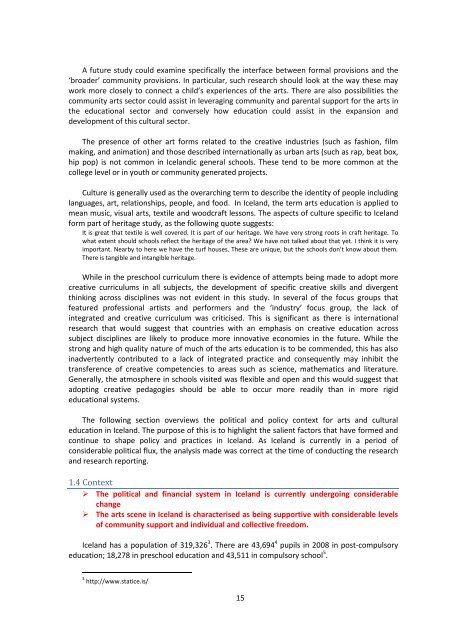
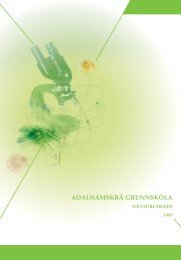
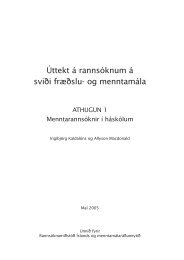

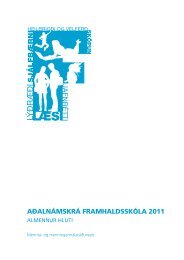
![Aðalnámskrá tónlistarskóla : rytmÃsk tónlist [Eingöngu á rafrænu formi]](https://img.yumpu.com/50843672/1/184x260/aaalnamskra-tanlistarskala-rytma-sk-tanlist-eingangu-a-rafranu-formi.jpg?quality=85)
